https://littlelooms.com/cdn-cgi/image/format=auto/https://www.datocms-assets.com/70931/1732220357-mick-haupt-a95jhbihu8g-unsplash.jpg?auto=format&w=900

I think it’s safe to say that all weavers have a mystery yarn of some sort in their stash, and most of us have more than a few. Whether it’s a souvenir skein that lost its tag in transit or a mystery cone bought so long ago that the original contents have been forgotten, these yarns tend to sit around and collect dust. So, what’s a weaver to do?
Well, fortunately there are a few methods you can use to identify yarns and help you get those mystery yarns off the shelf and onto a loom! In this skill guide we’ll cover the steps you can take when approaching an unknown yarn. As you read, you’ll learn about:
- Steps for inspecting an unknown yarn
- Burn tests and what we can learn from them
- How to use a yarn balance to tell yards per pound
- How to use the Master Yarn Chart
Every item we’ve selected for this guide is part of your All Access program and will help you get the most out of your subscription. Check out the Little Looms Library and our video course website for more learning opportunities.
Happy Weaving,
Christina
Figuring Out Fiber
Adapted from “String Theory: Identifying the Fiber Content of Mystery Yarns” by Deanna Deeds
Almost every weaver eventually ends up in this scenario: you have a particular skein, tube, or cone of yarn, and you’d like to use it in a project ... but you don’t know what the fiber content is. Maybe it was a freebie you picked up—or it was a gift—or you bought it so long ago you can’t remember, and the label has long ago fallen off and been lost forever. How do you know how the yarn will perform, how much it will shrink, how durable it will be, or how it will combine with other yarns?
[PAYWALL]
What you have on your hands is a mystery yarn. I volunteer every week at our city’s senior center, helping people weave. The weaving room has been blessed with donations over the many years: looms, equipment ... and yes, tons of yarn, most of which is unlabeled. We do a lot of mystery-yarn identification. To solve the mystery, you have to be a detective of sorts. Let’s explore a few tests that you can put in your detective’s tool kit that use four of the five senses: sight, touch, smell, and even hearing. Using more than one of these tests in combination can boost your confidence in your fiber hypothesis. At the very least, you will probably be able to narrow it down to cellulose versus protein or natural versus synthetic.
Sight
How does the yarn look? If it’s shiny, it could be silk, rayon, synthetic, or mercerized (pearl) cotton. If it’s a dyed yarn, how intense is the color? Wool accepts dyes readily, while linen won’t take dye as easily as cotton. The cotton mercerization process makes pearl cotton more dye-ready, too, so colors can be more intense than they are on unmercerized cotton. A yarn containing linen is hairy: it will have unruly stiff hairs sticking out of it that can be smoothed down by dampening the yarn. A yarn of wool fiber may also be hairy or fuzzy, but the fuzz will probably show some crimp—that is, tiny bends or kinks in the fiber. Try felting the yarn by rubbing it vigorously in hot water and plenty of detergent to determine whether it’s wool. (Just remember, some wool yarns are treated so they resist felting.) Alpaca can have long but soft hairs with little to no crimp, mohair has a big halo, and cashmere and other luxury fibers may have more of a light fuzz.
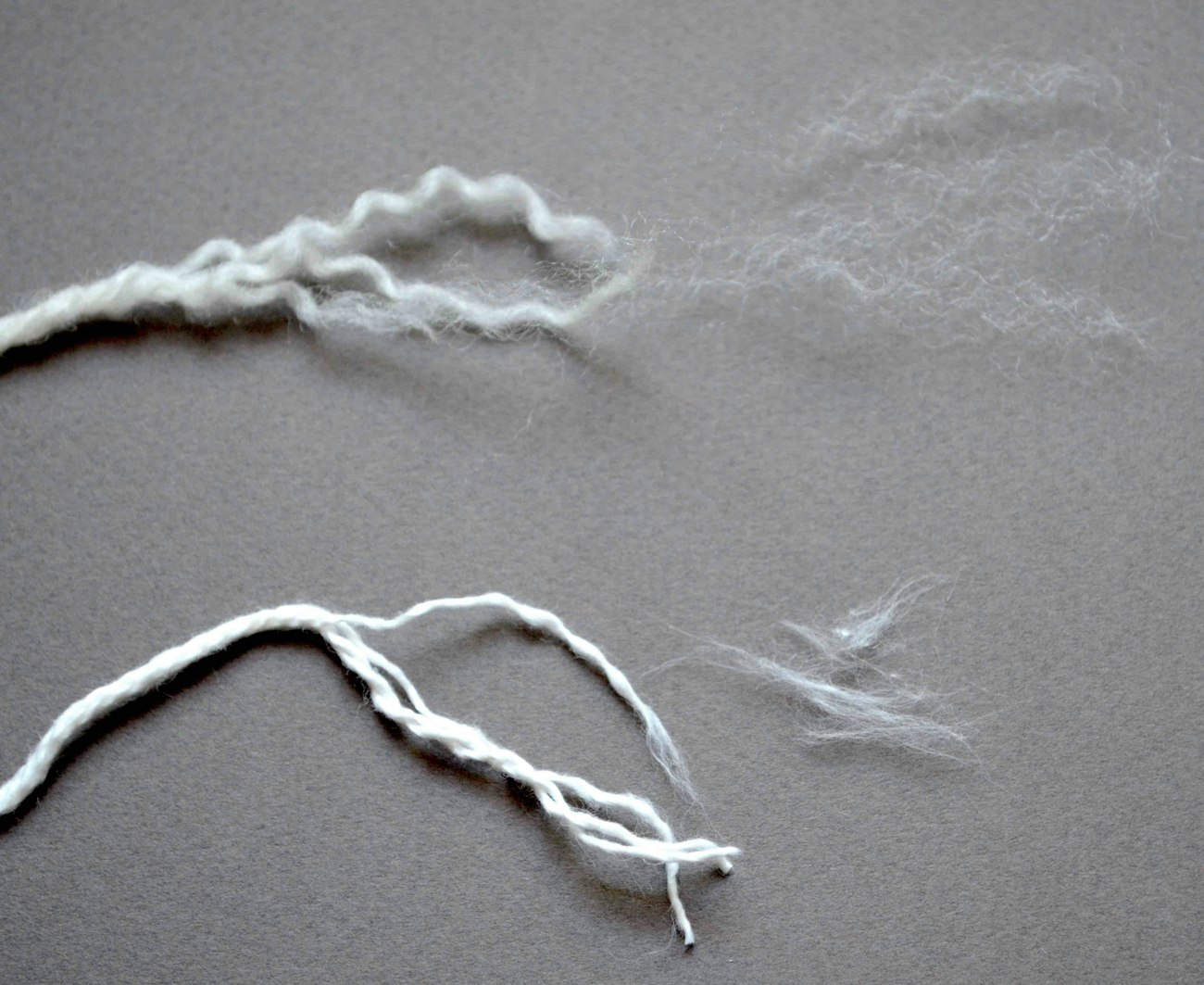 Deconstructed wool (top) and cotton (bottom). Notice the crimp in the individual wool fibers. Photo by Deanna Deeds
Deconstructed wool (top) and cotton (bottom). Notice the crimp in the individual wool fibers. Photo by Deanna Deeds
How do the fibers making up the yarn appear? Deconstruct your yarn: untwist the plies of the yarn, then unspin one of the plies enough to pull out some of the staple fibers and examine them for the qualities we’ve been discussing. If you can’t pull out individual fibers, you may have a filament yarn, which can be made from reeled silk or a manufactured fiber such as rayon. If the plies are different from one another, you probably have a yarn made from more than one fiber, so evaluate each ply separately.
Touch
How does the yarn feel? Is it soft and smooth or harsh and scratchy? A coarse wool or linen will feel harsher than a fine merino or a lyocell (which is often sold under the name Tencel). The stiffness of a yarn can provide a big clue about its content. Hold your yarn horizontally, with about a 2-inch length sticking out, and notice the angle at which it hangs. A likely candidate for a very limp and drapey yarn is some form of rayon or synthetic, or possibly silk. A cotton will have more body, and a bast fiber such as linen or hemp will be the stiffest.
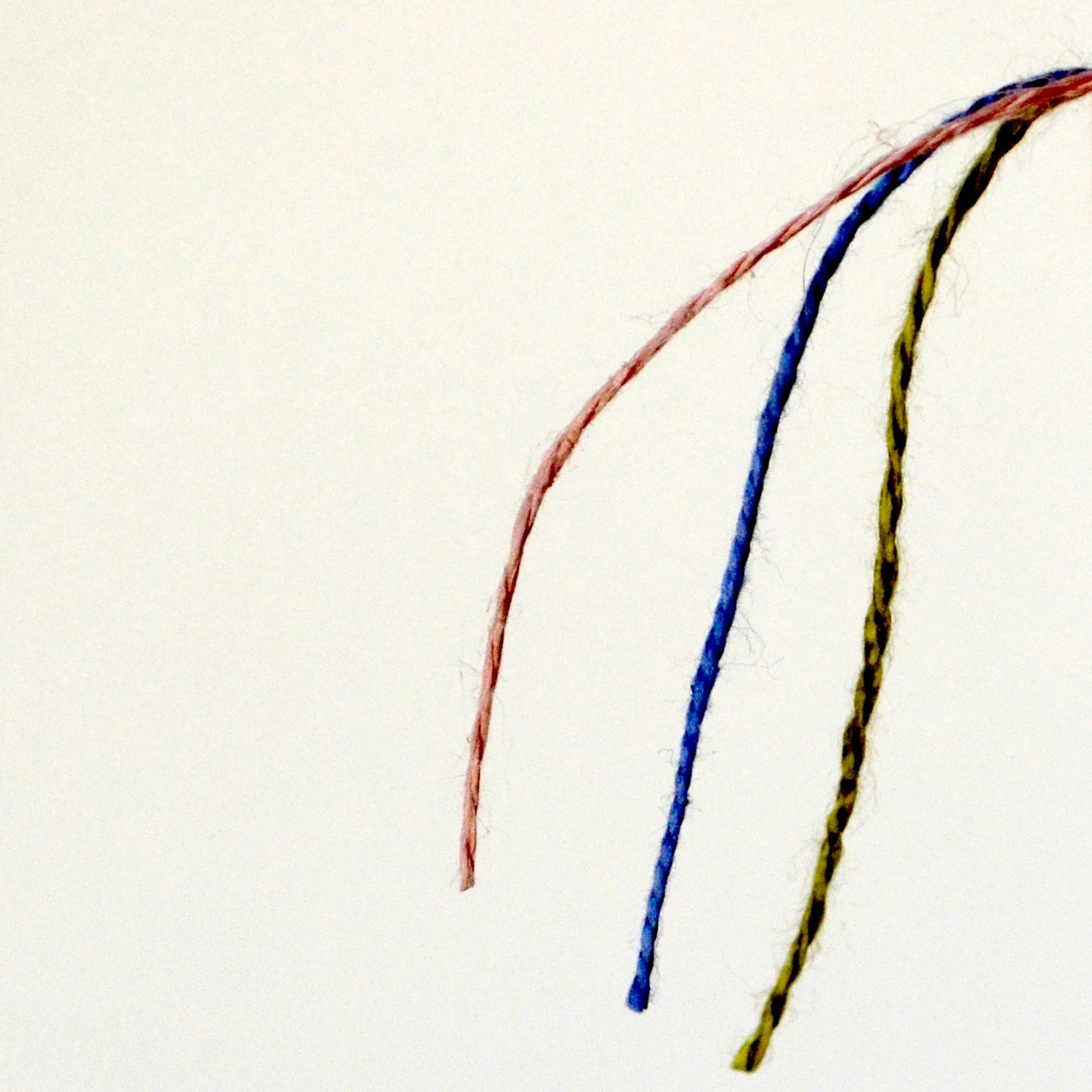 Stiffness test on three yarns of similar size, left to right: linen, cotton, bamboo rayon. Photo by Deanna Deeds
Stiffness test on three yarns of similar size, left to right: linen, cotton, bamboo rayon. Photo by Deanna Deeds
How easily does the yarn break? Silk, linen, and nylon are very strong. Cotton’s strength varies, and pearl cotton is very strong whereas unmercerized cotton breaks easily. Wool’s strength depends on the type. Keep in mind that the thickness, tightness of the spin, and age of the yarn can also affect these tests. Squeezing a skein is another feel test; if it’s silk, you might be able to feel a “squeakiness”—there might even be sound if you put it to your ear as you squeeze.
Burn Test
A burn test requires multiple senses, and you can learn much from the way yarn burns. Do this test carefully in a safe place, such as over your sink. Put a lit match to a short length of yarn, being careful not to burn yourself. Watch the behavior of the flame: Does it go out by itself? What color is the flame?
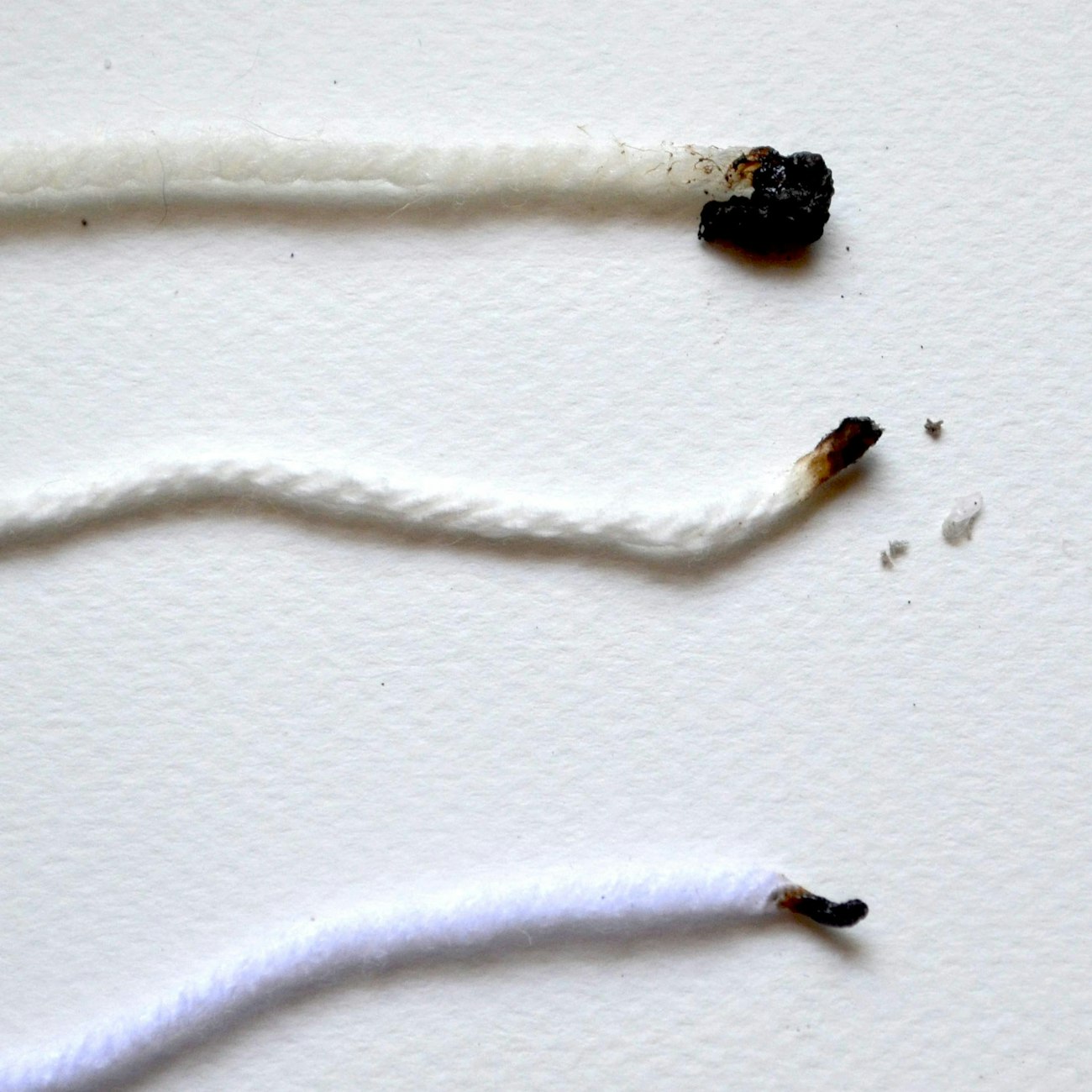 Results of a burn test, from top to bottom: wool—curls up as it burns, self-extinguishes, no ash; cotton—must be extinguished, ash remains; acrylic—melts as it burns, must be extinguished, no ash. Photo by Deanna Deeds
Results of a burn test, from top to bottom: wool—curls up as it burns, self-extinguishes, no ash; cotton—must be extinguished, ash remains; acrylic—melts as it burns, must be extinguished, no ash. Photo by Deanna Deeds
Notice the smell of the burning. We’ve all experienced having accidentally singed or overheated a hair or two; if you smell burnt hair, the yarn is a protein (animal) fiber. If it smells more like wood or paper burning, it’s a cellulose (plant) fiber—which can include rayon or lyocell, fibers made from cellulose but processed to behave more like silk. Observe what remains after the burn test: Is there any ash? If the end of the yarn just melted into a hard bead without producing any ash, you have a synthetic yarn. Refer to tables of burn test results available online and in fiber books.
If these tests are inconclusive, you may have a blend on your hands!
Your most useful tool will develop over time, and that is knowledge based on your experience with known fibers. From your stash, gather various yarns whose fiber content you know, in as wide a variety as possible. Become familiar with how the different fibers compare with one another using the methods described above. Then, when you come across a mystery yarn, you can compare it to your knowledge of familiar yarns and solve the puzzle.
Using a Yarn Balance
Adapted from “Measuring Handspun Yarn” by Elizabeth Prose
My favorite method for calculating the length of a skein is to measure grist in yards per a pound (ypp). Using a yarn balance (sometimes referred to as a McMorran yarn balance), I can measure just a sample of my handspun or any other mystery yarn.
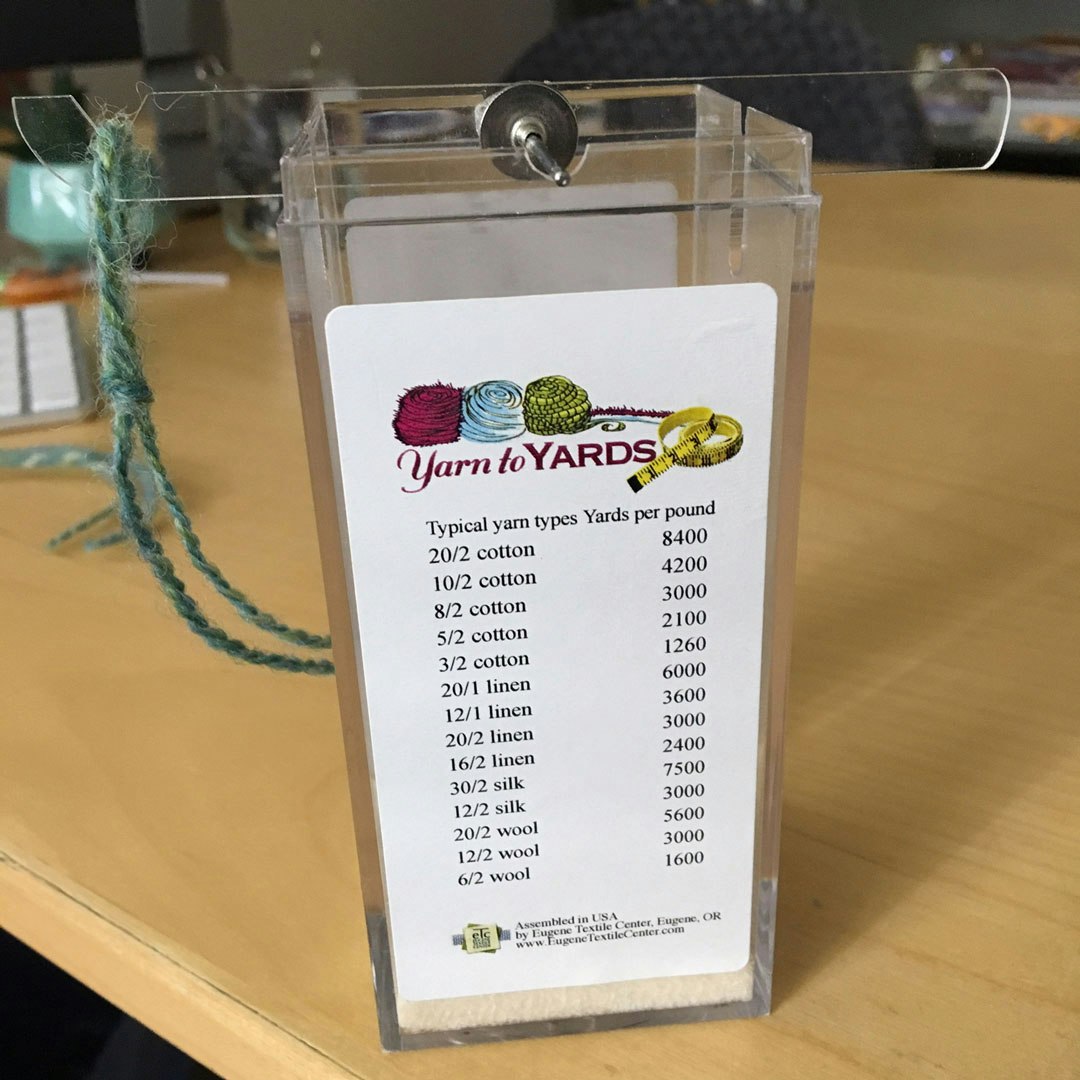 A yarn balance, sometimes known as a McMorran yarn balance, is a great tool for figuring out the yards per pound of handspun and mystery yarns. Photo by Elizabeth Prose
A yarn balance, sometimes known as a McMorran yarn balance, is a great tool for figuring out the yards per pound of handspun and mystery yarns. Photo by Elizabeth Prose
Here's how to use one of these tools:
Take a cut yarn sample and place it over the notch. The sample should be long enough to pull the notch down. Make sure the yarn hangs freely from the notch. (Pro tip: A loose slipknot in the middle of the yarn can help keep the yarn from falling off.)
Trim small amounts from the sample. It helps to keep a trash can beneath the table. As the arm starts to move, cut off smaller and smaller pieces.
Snip away slowly until the arm is balanced in a horizontal position.
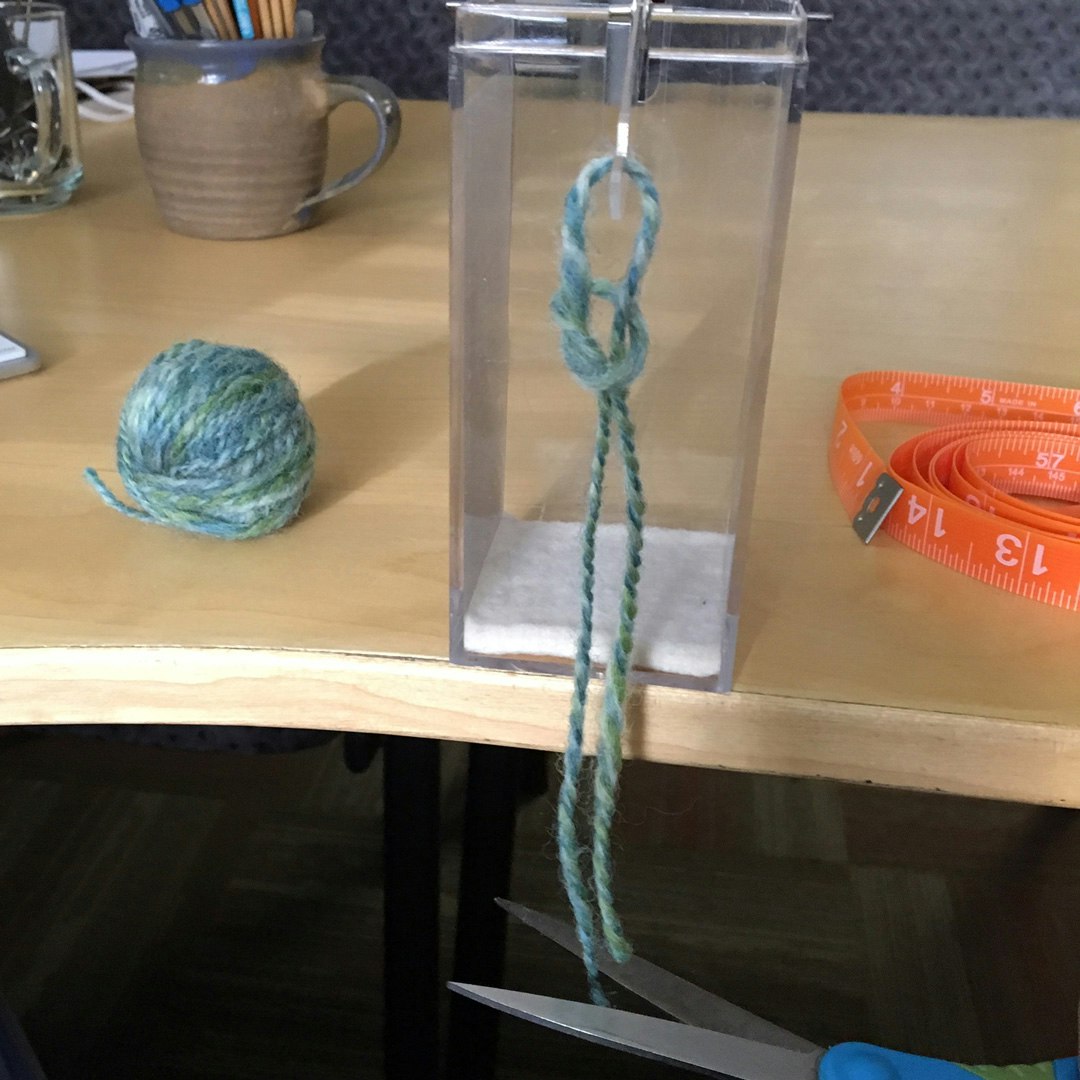 Very slowly snip the yarn until the arm balances. Be careful not to snip too much or you'll have to start the process from the beginning. Photo by Elizabeth Prose
Very slowly snip the yarn until the arm balances. Be careful not to snip too much or you'll have to start the process from the beginning. Photo by Elizabeth Prose
- Measure the length in inches and multiply by 100. For example, a 9-inch length indicates yarn measuring 900 ypp.
A yarn balance is an especially useful tool to have when measuring handspun yarn for large projects or any mystery yarn in your stash. Then, with my trusty digital scale and a little (very easy) math, I can also figure out the yardage of my skein.
Just remember, if you’re measuring handspun yarn, the results are just an approximation. Unless every yard is precious, sample a length from different places in the skein; a slight variation in grist can make a big difference when multiplied by 100. With commercially produced yarn, your results should be much more accurate.
Using the Master Yarn Chart
Adapted from “Mastering the Master Yarn Chart” by Christina Garton
If you don’t know about the Master Yarn Chart, you are in for a treat. For years at Handwoven, we would collect and scan samples of every single yarn used in an issue (Every. Single. One.) The scans would then go in the back of the magazine and later, into the Master Yarn Chart, along with basic information about the yarn: fiber content, yardage per pound, meterage per kilogram, and suggested setts for lace weaves, plain weaves, and twill. The chart was then organized by fiber type with all cotton and cotton blends together, silk and silk blends, wool and wool blends, etc.
Let’s use a recent question to explain how to use the Master Yarn Chart. A reader asked me about a project that used doubled 8/2 cotton in a 10-dent heddle. She wanted to know whether she could use quadrupled 16/2 cotton or single 8/4 cotton instead, and if so, how would that affect the final cloth? At first glance, it makes sense that 16/2 would be half the size of 8/2 cotton and 8/4 would be twice the size, but weaving yarns are never that easy. Off to the Master Yarn Chart!
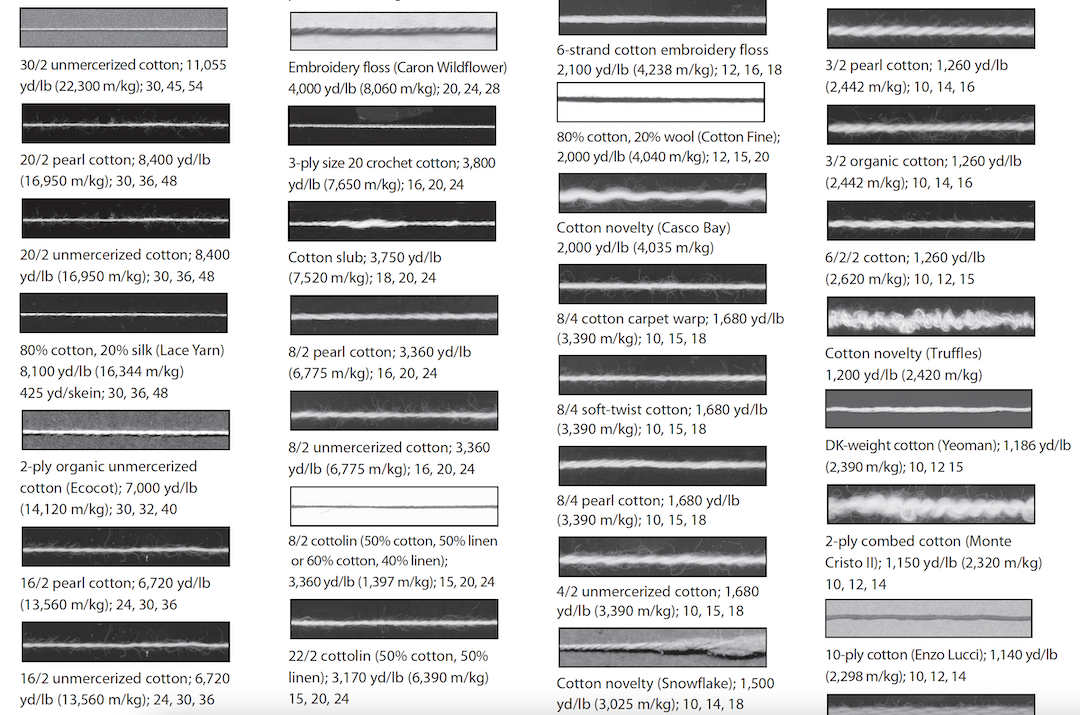
Looking at the chart, I can see that 8/2 cotton is 3,360 yd/lb and has a plain-weave sett of 20. On the other hand, 16/2 cotton is double the yardage per pound of 8/2 cotton at 6,720 yd/lb, but the suggested plain-weave sett is 30, not 40. So if you wanted to weave the same project with 16/2 cotton, you’d want to use the yarn tripled, not quadrupled.
Now let’s look at the 8/4 cotton. It comes in at half the yards per pound of 8/2 cotton (1,680 yd/lb) but again, the plain-weave sett isn’t 10, it’s 15. I was able to give the reader all this information in minutes, thanks to the Master Yarn Chart.
I use the chart all the time in my own weaving life to figure out yarn substitutions and setts. If you view the PDF or print it out at 100 percent, all the yarn scans are true to size, so you can compare mystery yarns from your stash to the ones on the list just by putting the physical yarn on the chart and comparing its size to other similar yarns. Then all you need to do is find a close match and you’ve got a sett! If I’m planning a project and can’t remember what yarn size will work at which sett, I just pull out the Master Yarn Chart. It’s not complete or perfect, but there’s much to love about this tool. It has helped me more times than I can count, and I hope it helps you out a bit, too!
Projects to Try
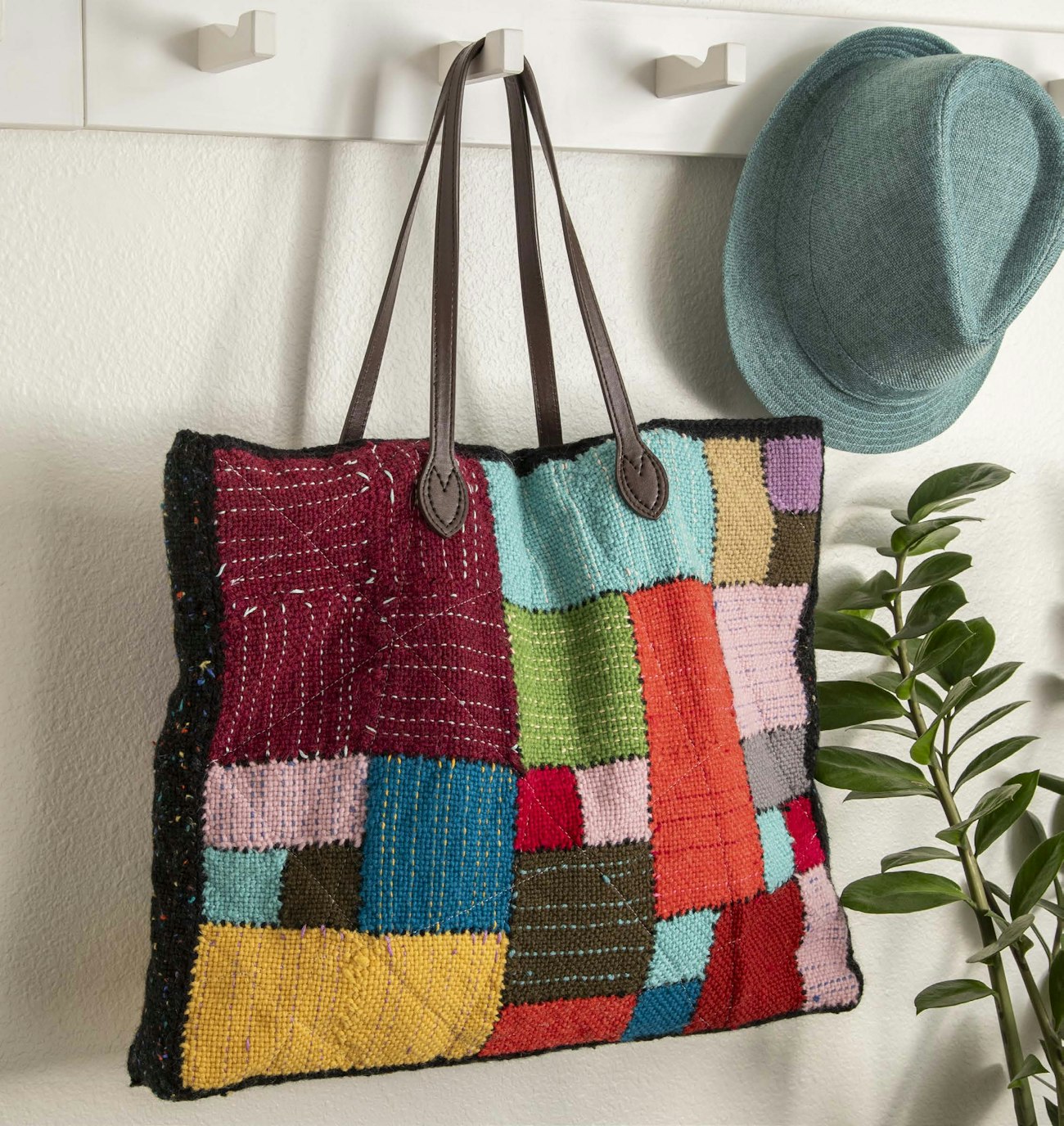 The Pin-Loom Patchwork Bag by Margaret Stump. Photo by Matt Graves
The Pin-Loom Patchwork Bag by Margaret Stump. Photo by Matt Graves
Margaret Stump’s Pin-Loom Patchwork Bag is a great project for leftover bits and bobs in your stash. Use the fiber identification tests to make sure you’re using yarns that won’t shrink when wet-finished. Find it in the Little Looms Library.
 The Pretty in Pink Handspun Scarf by Sally Papin. Photo by George Boe
The Pretty in Pink Handspun Scarf by Sally Papin. Photo by George Boe
While Sally Papin used handspun yarns for her Pretty in Pink Handspun Scarf, we think it°s also the perfect project for stash yarns! Follow Sally’s guidance for choosing yarns, and you’re sure to make something wonderful! Find it in the Little Looms Library.


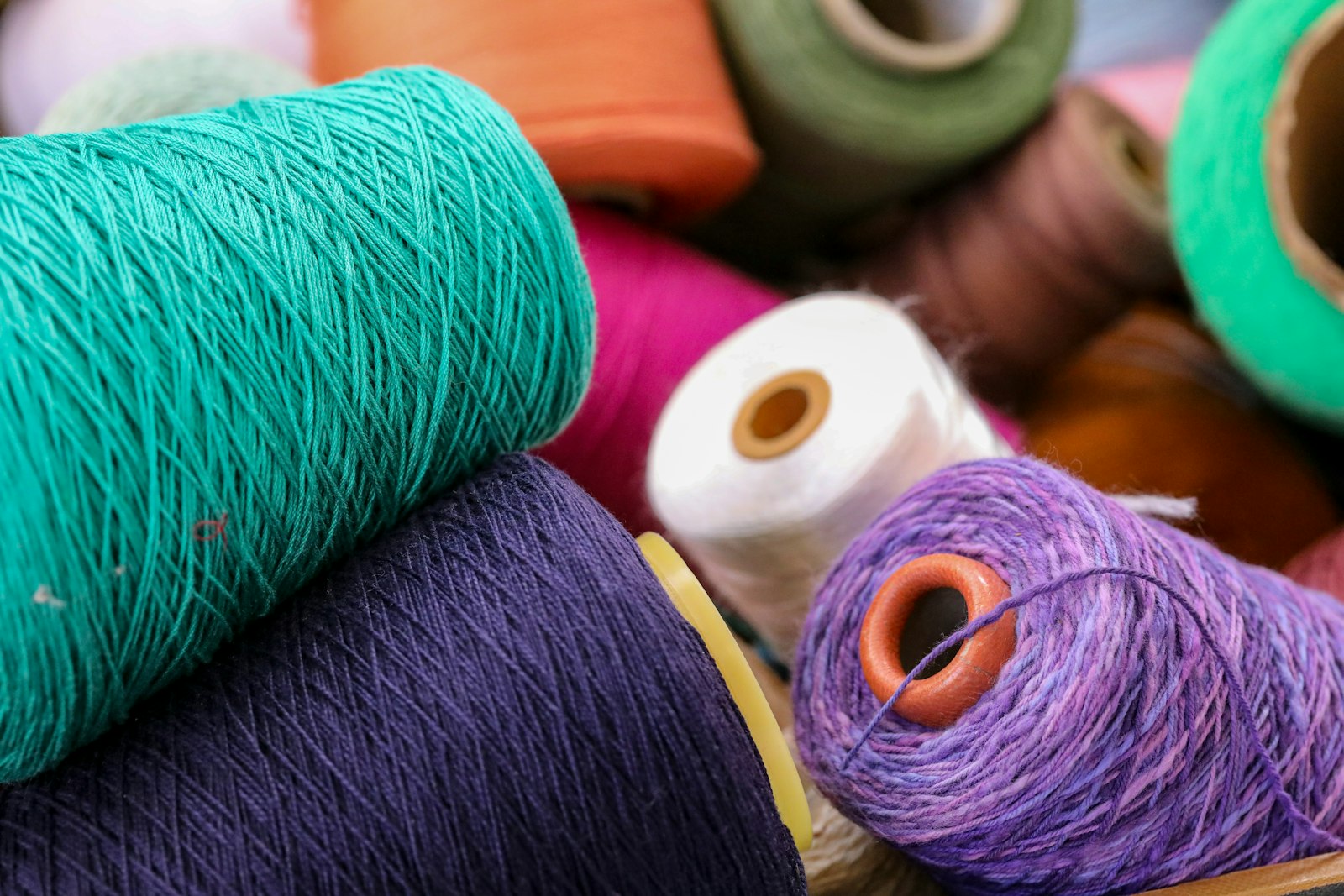
 Deconstructed wool (top) and cotton (bottom). Notice the crimp in the individual wool fibers. Photo by Deanna Deeds
Deconstructed wool (top) and cotton (bottom). Notice the crimp in the individual wool fibers. Photo by Deanna Deeds Stiffness test on three yarns of similar size, left to right: linen, cotton, bamboo rayon. Photo by Deanna Deeds
Stiffness test on three yarns of similar size, left to right: linen, cotton, bamboo rayon. Photo by Deanna Deeds Results of a burn test, from top to bottom: wool—curls up as it burns, self-extinguishes, no ash; cotton—must be extinguished, ash remains; acrylic—melts as it burns, must be extinguished, no ash. Photo by Deanna Deeds
Results of a burn test, from top to bottom: wool—curls up as it burns, self-extinguishes, no ash; cotton—must be extinguished, ash remains; acrylic—melts as it burns, must be extinguished, no ash. Photo by Deanna Deeds A yarn balance, sometimes known as a McMorran yarn balance, is a great tool for figuring out the yards per pound of handspun and mystery yarns. Photo by Elizabeth Prose
A yarn balance, sometimes known as a McMorran yarn balance, is a great tool for figuring out the yards per pound of handspun and mystery yarns. Photo by Elizabeth Prose Very slowly snip the yarn until the arm balances. Be careful not to snip too much or you'll have to start the process from the beginning. Photo by Elizabeth Prose
Very slowly snip the yarn until the arm balances. Be careful not to snip too much or you'll have to start the process from the beginning. Photo by Elizabeth Prose
 The Pin-Loom Patchwork Bag by Margaret Stump. Photo by Matt Graves
The Pin-Loom Patchwork Bag by Margaret Stump. Photo by Matt Graves The Pretty in Pink Handspun Scarf by Sally Papin. Photo by George Boe
The Pretty in Pink Handspun Scarf by Sally Papin. Photo by George Boe